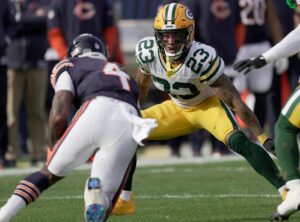Moving through the AFC North section of “The Breakdown,” LWOPF’s newest series, we take a look at what makes the Pittsburgh Steelers successful on both sides of the ball.
The Breakdown: A Look at the Pittsburgh Steelers Schematic Philosophy
Running with Variety
Todd Haley enters his sixth season as the Steelers offensive coordinator and he has helped turn Pittsburgh into a formidable offensive unit that plays to the strength of their personnel. His system is predicated on the power running game, but he incorporates a healthy dosage of zone and counter principles and primarily directs runs to the strength. Another Haley staple is the addition of fullbacks and tight ends to provide added pass protection and extra gaps, while further foundations of Haley’s ground game include pulling guards to the perimeter.
This aspect of the ground game is what suits running back Le’Veon Bell most efficiently. Overloading one of the side of the formation with one or two pulling blockers allows Bell to capitalize on his elite patience and hyper-awareness by manipulating his stride. This provides optimal tempo as his blocks develop. Once the blocking has taken shape, Bell’s slashing, cut-and-go style becomes his best asset as he quickly exploits the slimmest of openings to reach green grass.
The use of the fullback often creates a gap and leverage advantage once the down blocks have been taken care of and the strong-side pulls have effectively sealed defenders to manufacture a running lane. As for a different Haley staple, his use of counter trey has quickly become a winnable leverage battle. Traditionally, the run involves play-side down blocks with a backside guard and tackle/back pull with the former kicking out the end man on the line of scrimmage (EMLOS) and the latter acting as more of a lead blocker once he reaches the point-of-attack. The running back’s path will generally begin to the backside B gap before adjusting to his pulling blockers, calling for a rhythmic runner that Bell is.
In the passing game, the Steelers are as lethal as they come and present a legitimate argument as the NFL’s most dynamic unit. Haley’s use of a quick-strike system aids both Ben Roethlisberger and the receiving corps, particularly superstar Antonio Brown. It allows Big Ben to get the ball out much faster than in deep-drop back systems, take fewer hits and thus remain healthy. In Brown’s case, it helps him churn out yards after the catch and forces defenders to be the closest thing to perfect in their leverage.
Roethlisberger can get Brown the ball via bubbles and screens as the X from trips formations, with him catching and running to generate offense on plays that are great for short-to-medium situations. From there, Haley will feature the tight end (whether in-line or in the slot) and inside slot receiver on go routes on now screens, selling the vertical blocks as the defenses focus on Brown before uncovering down the seam and the perimeter for easy, uncontested gains. Haley’s use of trips is the base of his passing with traditional three-man concepts such as sail and snag.
Building on the Blitz
Pittsburgh has been a base 3-4 team for three decades, but defensive coordinator Keith Butler likes to build on that.
Butler’s defenses are built on aggression and intelligence, a zone-match unit that requires a great deal of football IQ without a necessary equal level of talent. This is why the Steelers rarely go for a defensive back in the first round of the NFL Draft. Butler’s ability to effectively marry that aggression and intelligence made life on opposing quarterbacks incredibly difficult. The majority of his Cover 2 looks are disguised in a bevy of pressure packages that differentiate on a down-to-down basis. That same coverage shell was played on the side that pressure came from. In so doing, it created an unusual look for offenses considering most defensive coordinators are against that many defenders on the same side of the field.
The crux of the Steelers’ blitzing history is the fire-zone blitz that features inside linebackers bringing pressure or sugaring the gaps only to drop into coverage with other disguised rushers. It’s a five-man pressure with trap coverage behind it that baits quarterbacks into throwing hot and disrupt’s the offense’s rhythm as quarterbacks have to combat the oncoming pressure by expediting their release. Specifically, the 2-Red Fire-Zone is a pattern matching Steeler staple where coverage responsibilities adjust on the fly and is ideally designed to shut down out/vertical concepts. The corners give a man look, but read the release of number two, squatting and trapping the flat if he releases to such area. The single-high safety then reads two to one and must match the number one vertical once the corner traps the flat. The movement and rotation is adept at putting these defenders in the desired areas of the field, significantly increasing their chances of capitalizing on the quarterback being baited.
Continuing the theme of pressure, few coaches send defensive backs-also known as “third-level” blitzers-in their pressure packages more than Butler. This area of success again refers back to Butler’s use of aggression and intelligence as quarterbacks are constantly unsuspecting of these blitzing corners. Butler capitalizes on this by rotating his trap coverages to the blitzing areas where such unsuspecting quarterbacks are found throwing into the teeth of the defense.
Schematic Philosophy Series
AFC East:
Buffalo Bills
Miami Dolphins
New England Patriots
New York Jets
AFC North:
Baltimore Ravens






